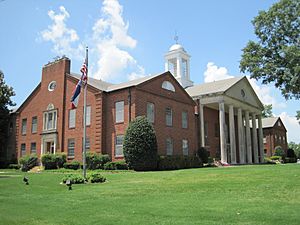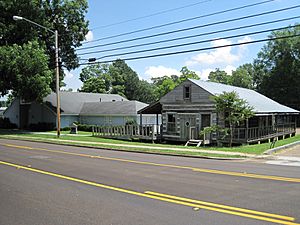DeSoto County, Mississippi facts for kids
Quick facts for kids
DeSoto County
|
|
|---|---|

DeSoto County Courthouse
|
|

Location within the U.S. state of Mississippi
|
|
 Mississippi's location within the U.S. |
|
| Country | |
| State | |
| Founded | February 9, 1836 |
| Named for | Hernando de Soto |
| Seat | Hernando |
| Largest city | Southaven |
| Area | |
| • Total | 497 sq mi (1,290 km2) |
| • Land | 476 sq mi (1,230 km2) |
| • Water | 21 sq mi (50 km2) 4.2% |
| Population
(2020)
|
|
| • Total | 185,314 |
| • Estimate
(2023)
|
193,247 |
| • Density | 372.9/sq mi (143.96/km2) |
| Time zone | UTC−6 (Central) |
| • Summer (DST) | UTC−5 (CDT) |
| Congressional district | 1st |
DeSoto County is a county located on the northwestern border of the U.S. state of Mississippi. As of the 2020 census, the population was 185,314, making it the third-most populous county in Mississippi. Its county seat is Hernando. DeSoto County is part of the Memphis metropolitan area. It is the second-most populous county in that statistical area. The county has lowland areas that were developed in the 19th century for cotton plantations, and hill country in the eastern part of the county.
Contents
History
The county is named for Spanish explorer Hernando de Soto, the first European explorer to reach the Mississippi River. The county seat, Hernando, is also named in his honor. De Soto allegedly died in that area in May 1542, although some believe that he died near Lake Village, Arkansas. See here for a list of sites associated with the 16th-century De Soto Expedition.
Early history
Indian artifacts collected in DeSoto County link it with prehistoric groups of Woodland and Mississippian culture peoples. Members of the Mississippian culture, who built complex settlements and earthwork monuments throughout the Mississippi River Valley, met Hernando DeSoto when he explored what is now North Mississippi. By tradition, he is believed to have traveled with his expedition through present-day DeSoto County. Some scholars speculate that DeSoto discovered the Mississippi River west of present-day Lake Cormorant, built rafts there, and crossed to present-day Crowley's Ridge, Arkansas. Based on records of the expedition and archeology, the National Park Service has designated a "DeSoto Corridor" from the Chickasaw Bluff (Memphis) to Coahoma County, Mississippi.
The Mississippian culture declined and disappeared; in most areas this decline preceded European contact and may have been for environmental reasons. The town named Chicasa, which De Soto visited, was probably the ancestral home of the historical Chickasaw, who were descended from the Mississippian culture. They had long lived in the area when white settlers began arriving as pioneers. Present-day Pontotoc, Mississippi developed near their "Long Town," made up of several villages close to each other. The Chickasaw claimed much of western Tennessee and northern Mississippi as their hunting grounds.
The Chickasaw people traded with the French, who established some settlements among them. France ceded its territories east of the Mississippi River to Britain following the Seven Years War. The United States acquired it by gaining independence from Britain.
Geography
According to the U.S. Census Bureau, the county has a total area of 497 square miles (1,290 km2), of which 476 square miles (1,230 km2) is land and 21 square miles (54 km2) (4.2%) is water.
Geographic features
- Mississippi River
- Coldwater River
- Arkabutla Lake
- Chickasaw Bluffs
Major highways
Adjacent counties
- Shelby County, Tennessee - north
- Crittenden County, Arkansas - west
- Tunica County - south
- Tate County - south
- Marshall County - east
Demographics
| Historical population | |||
|---|---|---|---|
| Census | Pop. | %± | |
| 1840 | 7,002 | — | |
| 1850 | 19,042 | 172.0% | |
| 1860 | 23,336 | 22.6% | |
| 1870 | 32,021 | 37.2% | |
| 1880 | 22,924 | −28.4% | |
| 1890 | 24,183 | 5.5% | |
| 1900 | 24,751 | 2.3% | |
| 1910 | 23,130 | −6.5% | |
| 1920 | 24,359 | 5.3% | |
| 1930 | 25,438 | 4.4% | |
| 1940 | 26,663 | 4.8% | |
| 1950 | 24,599 | −7.7% | |
| 1960 | 23,891 | −2.9% | |
| 1970 | 35,885 | 50.2% | |
| 1980 | 53,930 | 50.3% | |
| 1990 | 67,910 | 25.9% | |
| 2000 | 107,199 | 57.9% | |
| 2010 | 161,252 | 50.4% | |
| 2020 | 185,314 | 14.9% | |
| 2023 (est.) | 193,247 | 19.8% | |
| U.S. Decennial Census 1790-1960 1900-1990 1990-2000 2010-2013 |
|||
2020 census
| Race | Num. | Perc. |
|---|---|---|
| White | 108,466 | 58.53% |
| Black or African American | 55,972 | 30.2% |
| Native American | 298 | 0.16% |
| Asian | 3,023 | 1.63% |
| Pacific Islander | 137 | 0.07% |
| Other/Mixed | 7,257 | 3.92% |
| Hispanic or Latino | 10,161 | 5.48% |
As of the 2020 United States Census, there were 185,314 people, 65,220 households, and 47,230 families residing in the county.
2013
As of the 2013 U.S.census estimates, there were 168,240 people living in the county. 70.3% were non-Hispanic White, 21.5% Black or African American, 1.6% Asian, 2.6% Native American, 0.1% Pacific Islander, 5.0% were Hispanic or Latino (of any race). The median income for a family was $66,377 and the mean income was $75,875. DeSoto County has the highest median income in Mississippi and the second highest mean income after Madison County.
Attractions
DeSoto County is known for its golf courses. Velvet Cream, known as 'The Dip' by locals, is a landmark restaurant in the county. Operating since 1947, it is the oldest continually running restaurant in the county. In 2010, it was awarded 'Best Ice Cream in Mississippi' by USA Today. DeSoto County was also previously known as the home of Maywood Beach, a water park that closed in 2003 after more than 70 years of operation.
DeSoto County Museum
A popular attraction is the DeSoto County Museum located in the county seat of Hernando. The museum is open Tuesday through Saturday from 10–5. Admission is free but donations are encouraged. Exhibits include displays on Hernando DeSoto, Civil War history, French colonial and American antebellum homes of the county, civil rights, and the history of each of the county's municipalities.
An eighteenth-century French colonial log house (see photo to the right) has been preserved from the time of French trading and settlement along the Mississippi. This house is similar in style to several French colonial houses preserved in Ste. Genevieve, Missouri, where many French settled after France ceded its territory east of the Mississippi to Great Britain following its defeat in the Seven Years' War.
Hernando DeSoto Park
Hernando DeSoto Park, located on Bass Road 6 mi (9.7 km) west of Walls, is a 41 acres (17 ha) park that features a hiking/walking trail, river overlook, picnic area, and boat launch. It is the only location in DeSoto County with public access to the Mississippi River.
Communities
Cities
- Hernando (county seat)
- Horn Lake
- Olive Branch
- Southaven
Towns
Census-designated places
Unincorporated communities
- Cockrum
- Days
- Eudora
- Lake Cormorant
- Lake View
- Lewisburg
- Love
- Mineral Wells
- Nesbit
- Norfolk
- Pleasant Hill
- West Days
Former communities
Education
Public education in DeSoto County is provided by the DeSoto County School District, the school district for the entire county. It is the state's largest school district. The district is responsible for the operation of eight high schools, eight middle schools, three intermediate (Grades 3–5) and numerous primary schools.
Notable people
- Nakobe Dean, NFL, Philadelphia Eagles.
- John Grisham, lawyer, writer.
- Olivia Holt, actor, singer.
- Jerry Lee Lewis (1935-2022), singer, songwriter, pianist.
- Cody Reed, MLB pitcher, Tampa Bay Rays.
- Austin Riley, MLB third baseman, Atlanta Braves.
- Ricky Stenhouse Jr., NASCAR.
Media
- DeSoto Times-Tribune
- DeSotoCountyNews.com
Suggested reading
- Map Guide to the U.S. Federal Censuses, 1790–1920, Thorndale, William, and Dollarhide, William; Copyright 1987. (Historic state maps including evolution of DeSoto County)
See also
 In Spanish: Condado de DeSoto (Misisipi) para niños
In Spanish: Condado de DeSoto (Misisipi) para niños


